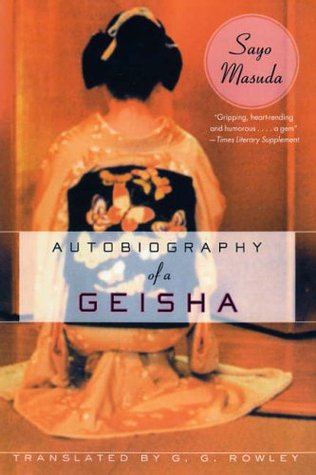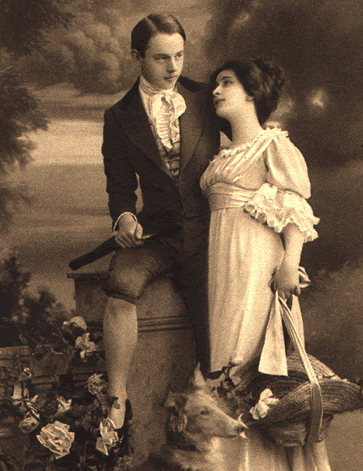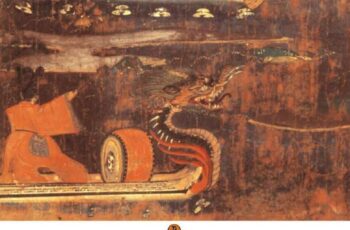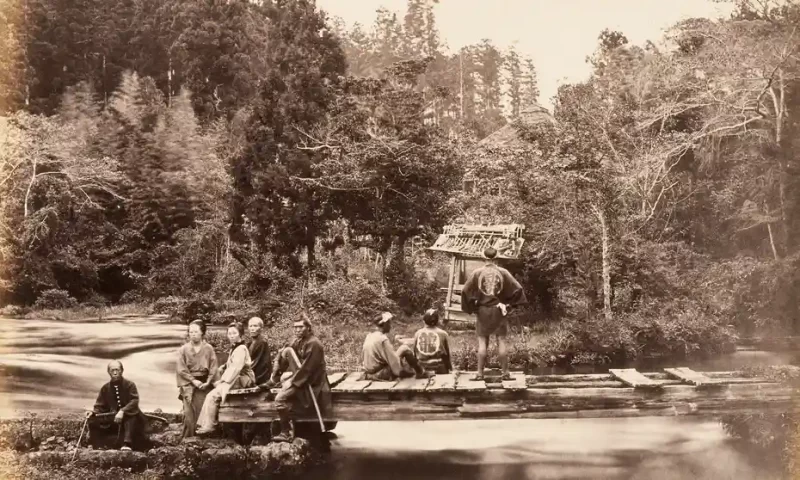
Lafcadio Hearn (1850-1904) offered a view into Japan during the Meiji Restoration with his books: Glimpses of Unfamiliar Japan, Out of the East, Kokoro, The Boy Who Drew Cats, In Ghostly Japan, Kwaidan, and other books. He lived in Japan for 14 years before his death; his writings provide a snapshot of the land and people and politics of the time. His initial passion for Japan colors his early writing, which eventually gave way to a more realist and deep view of Japan.
Hearn wrote for the general English-speaking public rather than for academics. This makes his work approachable. Along with Basil Hall Chamberlain, Hearn’s work proved invaluable for the West’s understanding of what-was-then an exotic culture. Hearn collected folklore and other stories with the help of his Japanese wife. Sometimes his folklore were the earliest written accounts.
Hearn’s work feels impressionistic. He tries to capture the feel and appearance of small moments for his Western readers by painting with his words and punctuation. His short essays often combine to create a larger impression just as Impressionist painters used their raw brushstrokes to create a landscape. Here’s an example:
Roused thus by these earliest sounds of the city’s wakening life. I slide open my little Japanese paper window to look out upon the morning over a soft green cloud of spring foliage rising from the river-bounded garden below. Before me, tremulously mirroring the Ohashigawa, opening into the grand Shinji Lake, which spreads out broadly to the right in a dim gray frame of peaks. Just opposite to me, across the stream, the blue-pointed Japanese dwellings have their to all closed; they are still shut up like boxes, for it is not yet sunrise, although it is day.
But oh, the charm of the vision,– those ghostly love-colors of a morning steeped in mist soft as sleep itself resolved into a visible exhalation. Lost reaches of faintly-tinted vapor cloud the far lake verge,–long nebulous bands, such as you mauve have seen in old Japanese picture-books, and must have deemed only artistic whimsicalities unless you had previous looked upon the real phenomena.
Hearn waxes purple in his writing more during his early years than his later years, but he retains his Impressionistic use of words. He’s fond of semicolons and comma-dashes (,–) to try to capture the pauses he experiences in the moment he describes. Here’s another example:
July 30. The next house to mine, on the south side,–a low,dingy structure,– is that of a dyer. You can always tell where a Japanese dyer is by the long pieces of silk or cotton stretched between bamboo poles before his door to dry in the sun,– broad bands of rich azure, of purple, of rose, pale blue, pearl gray. Yesterday my neighbor coaxed me to pay the family a visit; and after having been led through the front part of their little dwelling, I was surprised to find myself looking from a rear veranda at a garden worthy of some old Kyoto palace. There was a dainty landscape in miniature, and a pond of clear water peopled by goldfish having wonderfully compound tails.
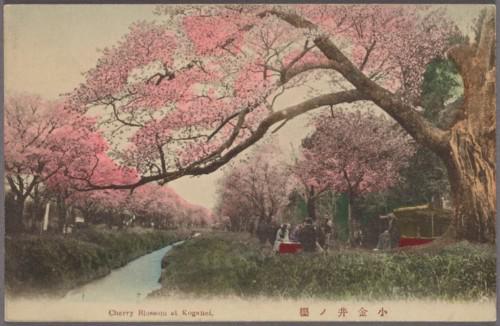
Hearn’s vignettes often read like a travel diary as he shifts his focus from the land to the people and their behavior. Only later in life did he start to delve into politics. He lampoons the shift from traditional society and toward a more Western and modern society. Hearn doesn’t hesitate to complain about Tokyo in particular. Hearn fell in love with the slower countryside and traditional architecture.
He worried about what the loss of culture meant for Japan. Some of his concerns are still in the process today. For example, geisha are slowly going extinct as a profession, and with that extinction will also go many traditional songs, dances, games, and stories. In the United States, we see a similar problem. Traditional family recipes disappear as people move away from cooking and canning. American practices like Sunday family and worship time have all-but ceased to exist. Urbanization, much like what Japan was undergoing during Hearn’s time, comes at a cost of traditional, rural culture.
Behind Hearn’s writings sits a desire to show the Japanese as they are, apart of the exoticism and generalizations we still here in the West despite over a century of cultural exchange. In a letter of Chamberlain, Hearn wrote: “Lowell says the Japanese have no individuality. I wish he had to teach here for a year, and he would discover some of the most extraordinary individualities he ever saw.” However, some of our continued generalized impressions of Japan come from Hearn’s impressionistic renderings of ideal Japan: a place of peace and nature.
In his later years, Hearn’s observation of Japanese society became less positive and held more concern. His view of societal pressures on the Japanese people remains relevant not only for Japan, but for those of us in Western culture. I will quote the passage at length:
As for being acted upon, the average man is under three kinds of pressure: pressure from above, exemplified in the will of his superiors; pressure about him, represented by the common will of his fellows and equals; pressure from below, represented by the general sentiment of his inferiors. And this last source of coercion is not the last formidable.
Individual resistance to the first kind of pressure–that represented by authority–is not even to be thought of; because the superior represents a clan, a class, an exceedingly multiple power of some description; and no solitary individual, in the present order of things, can strive against a combination. To resist injustice he must find ample support, in which case his resistance does not represent individual action.
Resistance to the second kind of pressure–communal coercion–signifies ruin, loss of the right to form a part of the social body.
Resistance to the third sort of pressure, embodied in the common sentiment of inferiors, may result in almost anything,–from momentary annoyance to sudden death,–according to circumstances.
In all forms of society these three kinds of pressure are exerted to some degree; but in Japanese society, owing to inherited tendency, and traditional sentiment, their power is tremendous.
Thus, in every direction, the individual finds himself confronted by the despotism of collective opinion; it is impossible for him to act with safety except as one unit of a combination. The first kind of pressure deprives him of moral freedom, exacting unlimited obedience to orders; the second kind of pressure denies him the right to use his best facilities in the best way for his own advantage (that is to say, denies him the right of free competition); the third kind of pressure compels him, in directing the actions of others, to follow tradition, to forbear innovations, to avoid making any changes, however beneficial, which do not find willing acceptance on the part of his inferiors.
These are the social conditions which, under normal circumstances, make for stability, for conservation; and they represent the will of the dead. They are inevitable to the militant state; they make the strength of that state; they render facil the creation and maintenance of formidable armies. But they are not conditions favorable to success in the future international competition,–in the industrial struggle for existence against societies incomparably more plastic, and of higher mental energy.
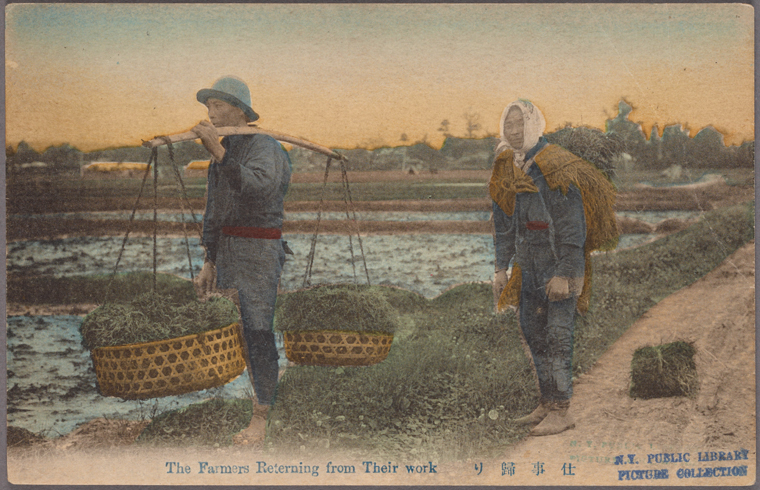
Hearn’s observations in this section foreshadow Japanese society during World War II; the roots were in the Meiji reforms and even deeper in the Edo period. You can also see the senpai-kohei relationship still present in Japanese society. Hearn touches on the tension between the individual and society and how difficult it is to stand according to your own moral view under these three pressures. The passage, written late in his life, lacks the idealism of his earlier work, but it teems with concern for the Japanese people he had grown to love.
Lafcadio Hearn is a must read for anyone who wants to learn more about Japanese history, but you need to read it with some care. He idolizes old Japan, and his work, while trying to stop the exotic perspective of the West, has become that exotic perspective. His work reveals as much about him as it does about Japan during the turn of the 1900s. His writing ranges from ghost stories to small accounts of his daily life in Japan. Because he writes for a general audience, his work, as you’ve seen, lacks the technicality of academic writers. It’s readable and offers a perspective of history that has sometimes been lost in Japan’s push to modernity.
Reference
Richie, Donald; editor (1997) Lafcadio Hearn’s Japan: An Anthology of His Writings on the Country and Its People. Tuttle Publishing.
